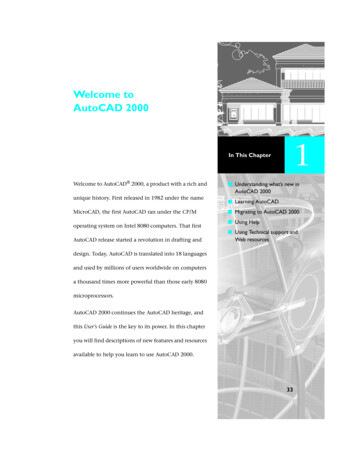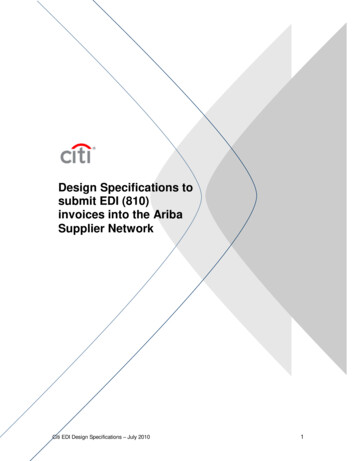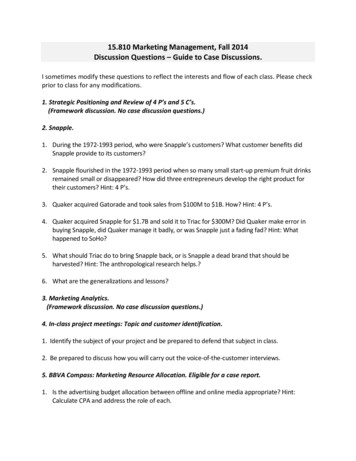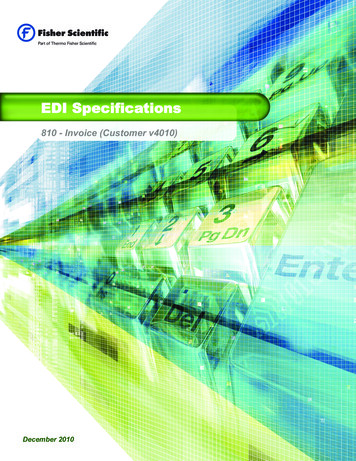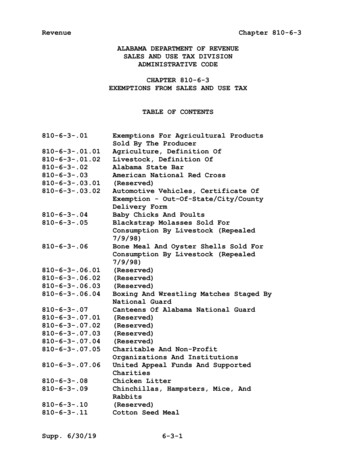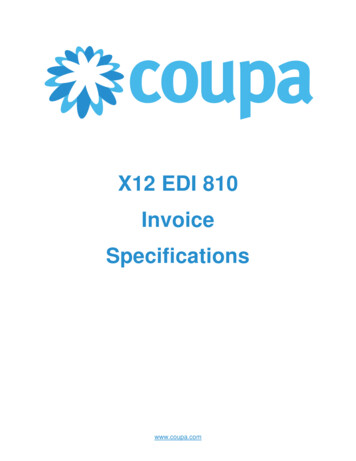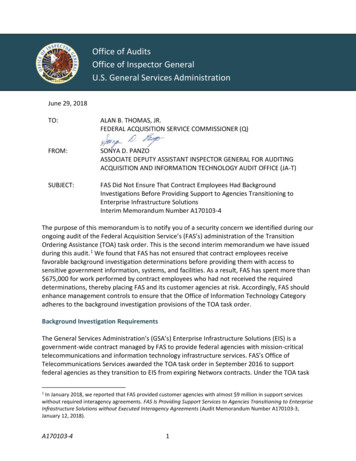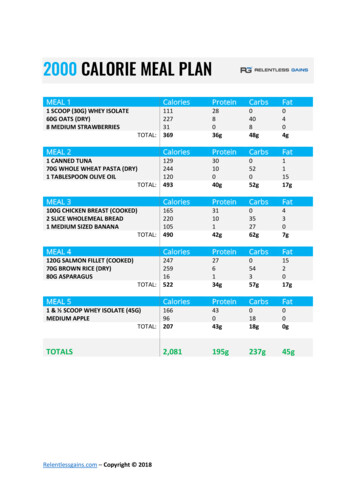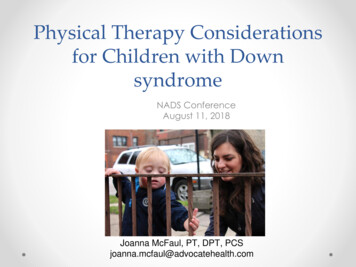
Transcription
United StatesEnvironmental ProtectionAgencyOffice of Chemical Safety andPollution Prevention(7510P)EPA 712-C-17-002February 2018Product Performance TestGuidelinesOCSPP 810.2000:General Considerations forTesting Public HealthAntimicrobial PesticidesGuidance for Efficacy Testing
NOTICEThis guideline is one of a series of test guidelines established by the United States EnvironmentalProtection Agency’s Office of Chemical Safety and Pollution Prevention (OCSPP) for use in testingpesticides and chemical substances to develop data for submission to the agency under the ToxicSubstances Control Act (TSCA) (15 U.S.C. 2601, et seq.), the Federal Insecticide, Fungicide, andRodenticide Act (FIFRA) (7 U.S.C. 136, et seq.), and section 408 of the Federal Food, Drug, andCosmetic Act (FFDCA) (21 U.S.C. 346a), referred to hereinafter as the harmonized test guidelines. Priorto April 22, 2010, OCSPP was known as the Office of Prevention, Pesticides, and Toxic Substances(OPPTS). To distinguish these guidelines from guidelines issued by other organizations, the numberingconvention adopted in 1994 specifically included OPPTS as part of the guideline’s number. Any testguideline developed after April 22, 2010 will use the new acronym (OCSPP) in its title.The OCSPP test guidelines serve as a compendium of accepted standardized methodologies andprotocols that are intended to provide data to inform regulatory decisions under TSCA, FIFRA, and/orFFDCA. This document provides guidance for conducting the tests, and are also used by EPA, the public,and the companies that are subject to data submission requirements under TSCA, FIFRA and/or FFDCA.As a guidance document, these guidelines are not binding on either EPA or any outside parties, and theEPA may depart from these guidelines where circumstances warrant and without prior notice. At placesin this guidance, the agency uses the word “should.” In this guidance, use of “should” with regard to anaction means that the action is recommended rather than mandatory. The procedures contained in thisguideline are strongly recommended for generating the data that are the subject of the guideline, but EPArecognizes that departures may be appropriate in specific situations. You may propose alternatives to therecommendations described in these guidelines, and the agency will assess them for appropriateness ona case-by-case basis.For additional information about these test guidelines and to access these guidelines electronically, seeEPA’s Test Guidelines for Pesticides and Toxic Substances site at toxic-substances. You may also access the guidelines at http://www.regulations.gov andsearching by Docket ID #: EPA-HQ-OPP-2015-0276.i
Table of Contents(A)(B)(C)(D)(E)(F)(G)Scope . 1(1) Applicability. . 1(2) Background. . 1Purpose and Overview—Product Performance. 1(1) General Concepts. . 1(2) Series Organization. . 1(3) Guideline Updates. . 2(4) Good Laboratory Practice Standards. . 2(5) Procedural Modifications of Recommended Methods. . 2(6) Other Methods. . 3(7) Confirmatory Data. . 3(8) Agency Verification of Efficacy. . 4(9) Failure of Performance. . 4Public Health and Non-Public Health Uses of Antimicrobial Products . 4(1) Antimicrobial Products with Public Health Claims. . 4(2) Antimicrobial Products with Non-Public Health Claims. . 5Definitions . 6General Testing Considerations . 8(1) Test Substance . 8(2) Test Methods . 10(3) Test Organisms. . 11(4) Control Carrier Counts. . 12(5) Porous Test Materials. . 12(6) Dilution of Products for Testing – Hard Water Guidance. . 12(7) Soil Load (Organic Burden). . 13(8) Contact Time (Exposure Period). . 13(9) Neutralization Confirmation. 14(10) Batch Replication for Modified Testing. . 14(11) Repeat Testing. . 15Data Collection and Reporting . 16References . 17List of TablesTable 1. Organization of the OCSPP Test Guideline Series 810 for Antimicrobial Products . 2Table 2. Lower Certified Limit (LCL) Requirements for Efficacy Testing of New Registrations orAmendments to a Registered Product. 9ii
OCSPP 810.2000: General Considerations for Testing Public Health Antimicrobial Pesticides(A) Scope(1)Applicability. OCSPP Test Guideline Series 810.2100 through 810.2700 describe generalinformation regarding product performance testing of public health antimicrobial pesticides tomeet requirements of the Federal Insecticide, Fungicide, and Rodenticide Act(FIFRA)(7 U.S.C. 136, et seq.) and the Federal Food, Drug, and Cosmetic Act (FFDCA)(21 U.S.C. 346a).(2)Background. Microbial pests can be categorized into two basic types: 1) those that presentpotential public health hazards because they pose a threat to human health, including but notlimited to, microorganisms infectious to humans in any area of the inanimate environment (publichealth claims) and 2) those microorganisms of economic or aesthetic significance (such asspoilage, fouling, or production of offensive odors in the substrate in which they grow, or causingbiological deterioration of a material(s), where the presence of the microorganism would notnormally lead to infection or disease in humans (non-public health claims)).The OCSPP 810 Test Guideline Series addresses antimicrobial pesticide products with publichealth uses or that bear public health claims for which product performance test data are requiredto be submitted to the agency to support registration or amended registration, including therequirements of 40 CFR § 158.2220(a)(2). This document provides an update to the 2012 OCSPPguideline 810.2000 and supersedes previous guidance.(B) Purpose and Overview—Product Performance(1)General Concepts. Evaluation of product performance is conducted based on expressed andimplied labeling claims or recommendations which may include pests, sites, methods ofapplication, application equipment, dosage rates, timing and number of applications, usesituations, nature and level of pest control, duration of pest control, compatibility with otherchemicals, benefits and/or adverse effects of product use, compatibility of common practicesassociated with the sites, and ingredient status of chemicals in the formulation.(i) Laboratory and/or simulated-use testing is designed and intended to determine theeffectiveness of a substance, or mixture of substances, to control or kill specific pestorganisms, when those substances are used in accordance with label instructions.(ii) In some cases, effectiveness and usefulness of the proposed product is further determinedthrough advanced large-scale laboratory tests, field tests, or simulated-use tests using testmethods which closely approximate actual use and which employ typically usedapplication equipment (e.g., fumigant sterilants).(2)Series Organization. Table 1 outlines the organization of the OCSPP Test Guideline Series 810;Group B — Antimicrobial Efficacy Test Guidelines:1
Table 1. Organization of the OCSPP Test Guideline Series 810 for Antimicrobial ProductsGuideline NameGeneral Considerations for Testing Public Health Antimicrobial Pesticides –Guidance for Efficacy TestingSterilants, Sporicides, and Decontaminants – Guidance for Efficacy TestingDisinfectants for Use on Environmental Surfaces – Guidance for EfficacyTestingSanitizers for Use on Hard Surfaces – Efficacy Data RecommendationsDisinfectants and Sanitizers for Use on Fabrics and Textiles – Efficacy DataRecommendationsAir Sanitizers – Efficacy Data RecommendationsDisinfectants and Sanitizers for Use in Water – Efficacy DataRecommendationsProducts with Prions-Related Claims – Efficacy Data RecommendationsOCSPPGuideline 2500810.2600810.2700(3)Guideline Updates. The agency recognizes that novel technologies and claims associated withantimicrobial products may evolve over time and would potentially involve test methods that arenot referenced in the guideline series. In addition, the agency is considering adopting the use ofquantitative test methods as an alternative or replacement to several current qualitative methods[e.g., Association of Official Analytical Chemists (AOAC International) Use-Dilution Methods].The agency expects to update the guidelines periodically to address such changes; however, theuse of new methods may occur prior to guideline updates. In these instances, new methods whichmay also be presented as Standard Operating Procedures (SOPs) may be published on the EPA’swebpage until such time that they can be added to the guidelines (Antimicrobial Testing Methods& Procedures Developed by EPA's Microbiology Laboratory). Once a new method is finalizedand published on the agency webpage, an applicant may utilize the method for productperformance testing. Applicants should consult with the agency for any method modificationsprior to testing. Applicants also have the option to submit alternative protocols for agency review.(4)Good Laboratory Practice Standards. Good Laboratory Practice (GLP) Standards as definedin 40 CFR Part 160 apply to studies submitted to support the registration or amendment ofantimicrobial products with public health claims. According to 40 CFR §160.17: “EPA mayrefuse to consider reliable for purposes of supporting an application for a research or marketingpermit any data from a study which was not conducted in accordance with this part.” 40 CFR§160.12 requires any study submitted to EPA to support an application for a research or marketingpermit to include statements signed by the applicant that “[a] the study was conducted inaccordance with this part; [b] describing in detail all differences between the practices used in thestudy and those required by this part; or [c] that the person was not a sponsor of the study, did notconduct the study, and does not know whether the study was conducted in accordance with thispart.”(5)Procedural Modifications of Recommended Methods. When an applicant seeks to modifyrecommended methods to support specific claims and/or use patterns for a product, the applicantshould submit the proposed testing protocol which clearly identifies, describes, and justifies eachmodification to the agency for review and evaluation prior to initiation of the test. Validation of2
the modification may be necessary prior to agency approval. The final study report should identifyand describe each modification.(i) The agency recommends that the registrant consult with the agency prior to initiation oftesting to confirm that the proposed changes in methods do not require submission of aformal protocol.(ii) An applicant may not be required to submit a protocol for agency review prior to testingwhen it uses:(a) alternative test organisms in recommended methods, including modifications tosupport the growth and recovery of the alternative strain (e.g., modification ofgrowth/recovery media, incubation temperature, recovery method), or(b) uses alternative carrier types in recommended methods.(6)Other Methods. When recommended methods, or modifications thereto, are not employed todevelop product performance efficacy data, complete testing protocols should be submitted to theagency for review and evaluation prior to initiation of the test. All pertinent information,including protocols, should be included with the final study reports. All materials and proceduresemployed in testing should be fully described. Where references to published reports or papersare made, copies or reprints of such references should be provided with the test reports.(7)Confirmatory Data. In certain situations, an applicant may rely on previously submitted productefficacy data to support a new application or amendment to a registration of a product and submitonly confirmatory efficacy data on the applicant's own finished product to verify the product’santimicrobial efficacy. In cases where confirmatory data are appropriate, the applicant shouldprovide confirmatory testing for each label claim, contact time, and organism class. If the testmethodology utilized in the supporting (cited) efficacy data was modified to include additionalelements not specified in the recommended method (e.g., organic soil, hard water), theconfirmatory data should be produced under similarly modified conditions.Specifically, formulation changes do not need confirmatory efficacy data when:(i) Only the concentration of a fragrance or dye is increased, substituted, or decreased in aformulation, and(ii) the concentration of fragrances does not exceed 1.0% (w/w) of the total formulation, or(iii) the total percentage of changes in dyes does not exceed 1.0% (w/w) of the total formulation.See OPP Pilot Fragrance Notification Program for additional information. For pressurized sprayproducts, certification should be furnished specifying that all parts and materials used inmanufacturing the container for pressurized spray disinfectants are identical to those in theregistered product.Examples of situations which do require the submission of confirmatory data are provided below.(i) Identical Product Formulations. In this situation, the applicant manufactures aformulation which is identical to a registered product that has complete supporting efficacydata, and the two products are not produced by the same manufacturer using the same3
production process. The chemical composition, label claims, and directions for use areidentical in substance to those of the original registration, and specific references (includingMaster Record ID [MRID] Numbers) to the supporting data developed for the identicalproduct are cited by the applicant. In this case, confirmatory data are needed to verify thatthe change in manufacturer (production process) does not impact the efficacy of the finalproduct.(ii) Minor Formulation Change in a Registered Product (Inerts Only). In this situation, theformulation change does not affect the concentration of the active ingredient(s) (e.g.,addition, substitution, increase, or decrease in an agency-approved inert ingredient). Thelabel claims and directions for use are unchanged from those accepted for the registeredformulation, and specific references (including MRID numbers) to the supporting datadeveloped for the original formulation are cited by the applicant. Confirmatory data areneeded to verify that the change in inert ingredient does not impact the efficacy of theproduct.For situations that are not addressed above, applicants are encouraged to consult with the agencyprior to the initiation of testing to inquire whether the submission of confirmatory data isappropriate.(8)Agency Verification of Efficacy. The agency reserves the option to perform its own testing, ona case-by-case basis, following the product specific test conditions used to register or amend theregistration of the product (e.g., contact time, hard water, dilution rate, and product applicationprocedure). The current version of the standard test method will be used for the evaluation ofefficacy.(9)Failure of Performance. Failure of performance of registered formulations and claims isreportable in accordance with 40 CFR § 159.188(a)(2).(C) Public Health and Non-Public Health Uses of Antimicrobial Products(1)Antimicrobial Products with Public Health Claims. A product makes a public health claim ifone or more of the following apply:(i) A claim is made for control of one or more specific microorganisms that are directly orindirectly infectious or pathogenic to humans (or both humans and animals).(ii) A claim is made for the pesticide product as a sterilant, disinfectant, virucide, sanitizer, ortuberculocide against one or more microorganisms that are infectious or pathogenic tohumans (or both humans and animals).(iii) A fungicidal claim is made against one or more fungi infectious or pathogenic to humans(or both humans and animals) or where the product does not clearly state that it is intendedonly for use against non-public health fungi.(iv) A claim is made for the pesticide product as a microbiological water purifier or microbialpurification system or swimming pool disinfectant/sanitizer.(v) A non-specific claim is made that the pesticide product will beneficially impact or affectpublic health at the site of use on/or in the environments in which it may be applied.4
(2)Antimicrobial Products with Non-Public Health Claims. For products that bear non-publichealth related claims, the agency generally does not require submission of efficacy data to supportsuch claims. However, the applicant is still responsible for ensuring that these products performas intended by developing efficacy data and keeping the data on file. The agency has theresponsibility of making sure that the use directions proposed for non-public health related claimsare appro
OCSPP Test Guideline Series 810.2100 through 810.2700 describe general information regarding product performance testing of public health antimicrobial pesticides to meet requirements of the Federal Insecticide, Fungicide, and Rodenticide Act (FIFRA)(7 U.S.C. 136, et seq.) and the Feder
